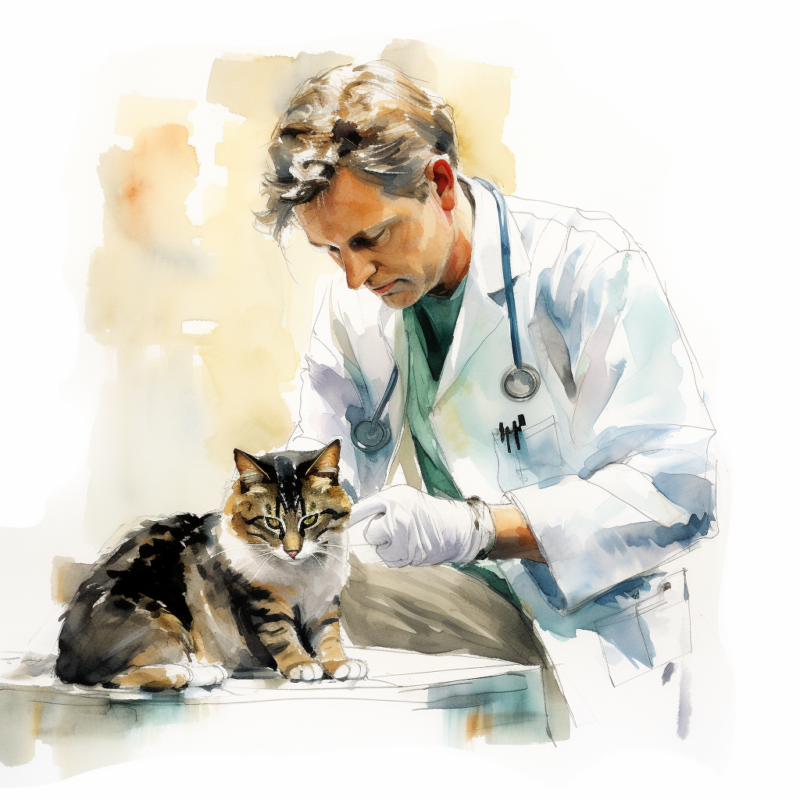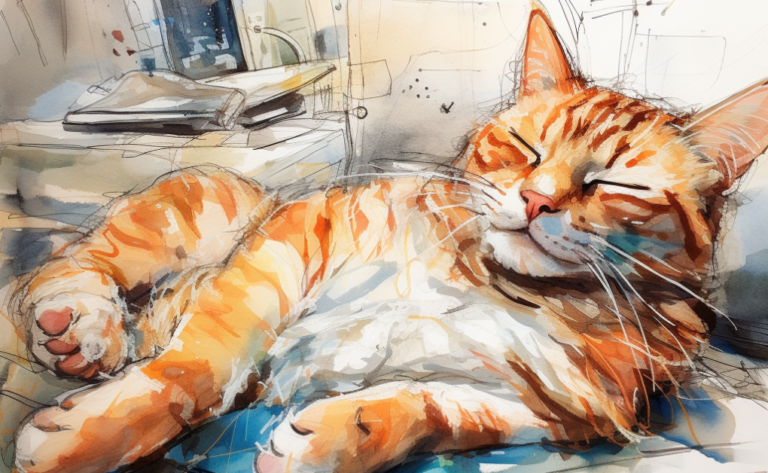What is Cancer in Cats?
What is it?
How is it Treated?
Breed Predispositions
Siamese Abyssinian Persian Burmese Ragdoll
Introduction
It was during a routine grooming session that Sarah first discovered a small lump on her beloved Abyssinian cat, Max. Worried about the mysterious growth, she immediately scheduled an appointment with her veterinarian. After a series of tests and a biopsy, Sarah received the heart-wrenching news: Max had cancer. In this blog post, we will explore the complex world of cancer in cats
Cancer, a disease where cells grow out of control and divide excessively, can lead to the formation of malignant tumors when cells multiply too rapidly. Individual cats are predisposed to developing specific kinds of cancer due to genetic factors, contributing to an increased risk in some breeds.
Among the various cancer cases in felines, one of the most prevalent is mammary carcinoma, commonly known as breast cancer. However, cancers that can affect cats are not limited to this. Other notable types include squamous cell carcinoma, fibrosarcoma, Mastocytoma, melanoma, lymphoma, leukemia, and plasmacytoma, among others.
Early diagnosis is crucial in managing cancer in cats, as it can significantly improve the chances of remission. Consequently, it’s essential to monitor any changes in your cat’s health and seek veterinary consultation when needed, as affected cats might require immediate attention.
Types of Cancer in Cats
Cats are susceptible to various forms of cancer, some of which bear similarities to those observed in humans. Recognizing these types can empower pet owners to identify symptoms early and seek immediate medical attention.
Lymphoma
Lymphoma, one of the most common forms of cancer, significantly affects cats, directly correlating to the feline leukemia virus (FeLV). It impairs lymphocytes, a type of white blood cell, instigating unchecked cell growth and tumor formation. Lymphoma predominantly affects the cat’s lymph nodes, liver, kidneys, intestines, or chest, manifesting symptoms such as weight loss, reduced appetite, vomiting, and diarrhea. In advanced stages, it may induce difficulty breathing.
Squamous Cell Carcinoma
Squamous cell carcinoma (SCC), synonymous with skin cancer in cats, chiefly targets the skin and the oral cavity, with the latter often referred to as mouth cancer. Light-colored or white cats exposed to sunlight are highly vulnerable to SCC, which can result in persistent sores around the face, ears, and mouth. Oral SCC may lead to difficulties in eating, excessive drooling, and unpleasant breath.
Mammary Gland Tumors
Like breast cancer in humans, mammary gland tumors rank third in cats’ list of most common cancers. This form of cancer predominantly affects female cats that either have not been spayed or were spayed post two years of age. Detectable lumps in the breast tissue are the primary indicators of this tumor, with changes in appetite and behavior marking additional symptoms.
Fibrosarcoma
Fibrosarcoma, a malignant form of cancer originating from connective tissues, can develop anywhere in a cat’s body, although it’s frequently found on the skin. This aggressive form of cancer often necessitates comprehensive surgical intervention, occasionally coupled with radiation therapy. Symptoms include a palpable growing mass, discomfort, or pain.
Mast Cell Tumors
Mast cell tumors develop from an immune cell named the mast cell. In cats, these tumors generally affect the skin but can also manifest in the spleen, liver, or gastrointestinal tract, contributing to intestinal cancer. Symptoms fluctuate greatly depending on the tumor location, including skin lesions, gastrointestinal complications, or overall uneasiness.

Osteosarcoma
Osteosarcoma, a rare but aggressive form of bone cancer in cats, primarily targets older cats, although it isn’t exclusive to this age group. It forms within the bone and can compromise bone integrity, potentially leading to fractures.
Leukemia
Feline leukemia, triggered by the feline leukemia virus (FeLV), can culminate in various forms of cancer and immunodeficiency, making the cat more susceptible to other infections. Outdoor cats are particularly at risk. Symptoms include anemia, lethargy, and gradual weight loss.
Lung Cancer
While lung cancer is relatively uncommon in cats, it can originate in the lungs (primary lung cancer) or metastasize from another part of the body (secondary lung cancer). This form of cancer generally affects older cats and is often linked with exposure to secondhand smoke. Symptoms can be elusive but may include coughing, breathing difficulties, and lethargy.
Oral Melanoma
Oral melanoma in cats is a type of cancer that originates in the cells that produce melanin, the pigment that gives color to the skin, hair, and eyes. While it is less common than squamous cell carcinoma, it can be more aggressive and tend to spread to other parts of the body. This cancer typically presents as a dark mass in the cat’s mouth but may not be noticed until it has grown large or spread to other areas.
Pancreatic Cancer
Pancreatic cancer in cats is rare, but it can be challenging to treat when it does occur. This cancer type affects the pancreas, an organ vital for digestion and insulin production. Symptoms are often nonspecific and can include weight loss, loss of appetite, and lethargy. Unfortunately, this type of cancer is often quite advanced before diagnosis, complicating treatment efforts.
Causes of Cancer in Cats
The occurrence of cancer in cats can be attributed to several factors:
Genetic Predispositions
Certain cat breeds or genetic lines may inherently be more prone to developing specific types of cancers. For instance, due to genetic factors, Siamese cats possess a heightened predisposition to develop skin cancer types, including squamous cell carcinoma.
Viral Infections
The Feline Leukemia Virus (FeLV) and Feline Immunodeficiency Virus (FIV) are major contributors to increased cancer risk. FeLV can trigger lymphosarcoma, a cancer affecting the bone marrow’s lymphoid tissues. Although FIV primarily leads to immunosuppression, it can augment susceptibility to various cancer types.
Environmental Influences
Exposure to certain environmental elements, including specific chemicals or toxins, can escalate a cat’s risk of developing cancer. For example, cats subjected to secondhand tobacco smoke are at a higher risk of developing malignant lymphoma and lung cancer. Certain insecticides and pesticides also present a potential cancer risk.

Age Factor
Like humans, the probability of developing cancer in cats increases with age. As cats age, they accumulate more genetic mutations, potentially leading to cancer-related abnormal cell growth. Consequently, an older cat is more likely to develop lymphoma and other types of cancer.
Additionally, research suggests that cats spayed at a young age may have a reduced risk of developing certain types of cancer, emphasizing the complex interaction between genetic, environmental, and lifestyle factors in cancer development.
Symptoms of Cancer in Cats
Cancer symptoms in cats can vary significantly depending on the type and location of the cancer. However, a few common clinical signs might indicate your feline companion could be dealing with this disease. Here are some of the symptoms of different forms of cancer in cats:
- Reduced Appetite: A cat with cancer may show a decreased interest in food, leading to noticeable weight loss.
- Weight Loss: Even if the cat continues to eat a normal diet, it may lose weight, often rapidly.
- Lumps or Swellings: Any unusual lumps, bumps, or swollen areas, especially those that continue to grow or change shape, could indicate a tumor. This could include an enlarged lymph node, often a sign of systemic illness.
- Non-healing Sores: Wounds or sores that don’t heal despite appropriate treatment can also indicate an underlying disease, including cancer.
- Abnormal Discharges: Any abnormal discharge, such as blood, pus, or other unusual substances from any body opening, should be a cause for concern.
- Difficulty with Normal Functions: If a cat has cancer, it may have trouble breathing, urinating, or defecating due to tumors affecting these bodily functions.
- Unexplained Bleeding: Any unexplained bleeding, either externally or internally (such as in the urine or stool), can be a symptom of cancer.
- Persistent Digestive Issues: Persistent or recurrent vomiting or diarrhea can be a sign of gastrointestinal cancers, among other health issues.
- Behavioral Changes: Changes in behavior, such as increased lethargy, decreased activity, or other unexplained changes, can often be one of the first signs that a cat is not feeling well. This includes cats that get cancer; they may not show specific signs of illness until the disease has progressed.
Remember, these symptoms can also be associated with other health issues, not cancer. Therefore, it’s always important to seek veterinary advice if your cat displays unusual signs or symptoms.
If Your Feline Has Cancer, What Should You Do?
If your cat has been diagnosed with cancer, staying calm and gathering as much information as possible is crucial. Understand the type of cancer, its stage, and available treatment options. If your primary vet is not an oncology specialist, consider consulting with a veterinary oncologist for expert advice on treatment strategies, potential side effects, and prognosis. Treatment options may include surgery, chemotherapy, radiation therapy, or immunotherapy, depending on the cancer type and stage.
Always keep your cat’s quality of life at the forefront of any decisions. Consider the impact of treatments on their well-being and daily life, and understand when it might be time to shift from curative efforts to palliative care or humane euthanasia. As you navigate this challenging time, closely monitor your cat’s behavior, appetite, and overall health, seeking veterinary advice if you notice any concerning changes. It’s also important to take care of yourself during this process; dealing with a pet’s illness can be emotionally taxing, and seeking support from friends, family, or pet loss support groups can be helpful.
Diagnosis of Cancer in Cats
Diagnosing cancer in a feline friend involves several steps that allow veterinarians to understand if and what type of cancer a cat might have. These steps include a physical exam, diagnostic imaging, biopsies, and blood tests.
Physical Examination
During a physical examination, your veterinarian may identify physical anomalies that may suggest the presence of cancer, such as an unusual lump, mass, or even changes in the oral cavity indicative of conditions like oral squamous cell carcinoma. Weight loss, alterations in gum color, or a diminished body condition could also signal underlying health issues.

Diagnostic Imaging
Diagnostic imaging plays a crucial role in visualizing the possible tumor. The growth’s size, location, and characteristics can be ascertained through imaging techniques such as X-rays and ultrasounds. For instance, an X-ray can reveal a mass in the lungs or bone structure, while an ultrasound may offer insights into the health of internal organs like the liver and kidneys. These techniques can also help detect issues like feline mammary tumors in the mammary gland, a common site of cancer in cats.
Biopsy
A biopsy, which involves taking a small tissue sample from the suspected tumor, is often required to confirm a cancer diagnosis. This sample, studied under a microscope, can verify the presence of cancer and provide information about its type and grade.
Blood Tests
Although blood tests can’t diagnose cancer independently, they give valuable information about a cat’s overall health and the presence of conditions often associated with cancer, like inflammation, infection, or anemia. The type of blood cells affected can also hint at the nature of the disease.
As cats live longer due to improved veterinary care, the incidence of diseases associated with old age, like cancer, is increasing. Consequently, regular veterinary check-ups are even more crucial for early diagnosis and effective treatment.
Treatment Options for Cancer in Cats
Your vet may suggest various treatment strategies once your cat has been diagnosed with cancer. The optimal course of treatment will be influenced by the type of cancer your cat is facing, its progression stage, and your cat’s overall health condition.
Early Stage Cancer
At this stage, cancers are generally localized, implying they have not spread beyond their initial site.
- Surgery
For many early-stage cancers, surgical removal is the primary treatment method. The aim is to excise the tumor and any neighboring lymph nodes containing cancer cells. The success of surgical treatment is contingent on factors such as the cancer type, location, and the individual cat’s overall health.
- Radiation Therapy
Radiation therapy, including potential laser therapy, might be an appropriate alternative for certain types of cancer that are localized but not easily amenable to surgery—like those located in the brain or near vital organs. This technique can often shrink the tumor, affecting surrounding tissue minimally and potentially delaying the disease’s progression.
Intermediate Stage Cancer
Intermediate-stage cancers may have started to invade local tissues or lymph nodes.
- Chemotherapy
Chemotherapy, combined with surgery, is often used for intermediate-stage cancer. This treatment method can shrink tumors before surgery, eradicate remaining cancer cells post-surgery, or serve as the primary treatment when surgical intervention isn’t feasible. Interestingly, cats tolerate chemotherapy relatively well, with common side effects such as skin irritation and hair loss being less prevalent than in humans.
- Targeted Therapy
Targeted therapies are newer medications designed to directly attack cancer cells, often causing fewer side effects than traditional chemotherapy. These therapies can be considered for specific cancer types with certain genetic mutations.
Advanced Stage Cancer
At this stage, cancers typically have metastasized to other organs.
- Palliative Care
At this advanced stage, treatment aims to maintain the quality of life rather than cure the cancer. This can involve pain management, nutritional support focusing on proper cat nutrition, and treatments to control symptoms like nausea or difficulty breathing.
- Immunotherapy
Immunotherapy, which stimulates the body’s immune system to combat cancer, can be a viable option for certain advanced cancers.
- Clinical Trials
Enrolling in a clinical trial may be a potential opportunity for cats with advanced-stage cancer. Clinical trials provide access to new and experimental treatments not yet widely available.
It’s important to remember that each cat’s situation is unique and can influence the choice of treatment. Moreover, the choice will depend on the cancer type and stage, the cat’s overall health, and the owner’s preferences and financial considerations. Certain cancers can be difficult to treat, so it’s crucial to thoroughly discuss with a veterinary oncologist to understand all available options and make an informed decision about your cat’s cancer and treatment plan.
Prevention for Cancer in Cats
While it’s impossible to eliminate the risk of cancer in cats, there are several strategies that pet owners can adopt to reduce their feline’s risk:
- Spaying/Neutering: Spaying female cats before their first heat cycle can significantly reduce the risk of mammary cancer. Neutering male cats eliminates the risk of testicular cancer.
- Vaccinations: Keeping your cat’s vaccinations up to date, especially the Feline Leukemia Virus (FeLV) and Feline Immunodeficiency Virus (FIV) vaccines, can help prevent cancers associated with these viruses.
- Healthy Diet: Feed your cat a balanced, nutritious diet to maintain a healthy weight. Obesity can increase the risk of certain types of cancer.
- Regular Vet Check-ups: Regular veterinary examinations can help detect cancer in its early stages when it is most treatable. The vet can also advise on preventative care and monitor your cat’s health.
- Limit Exposure to Carcinogens: Limit your cat’s exposure to known carcinogens such as tobacco smoke, certain pesticides, and excessive sunlight (which can cause skin cancer, particularly in white cats).
- Dental Care: Regular dental care can prevent oral cancers. Talk to your vet about the best methods of dental care for your cat.
- Regular Exercise: Regular exercise helps maintain a healthy weight and boosts overall health, potentially reducing cancer risk.
Remember, even with the best preventative care, there is always a risk that a cat may develop cancer. The best approach is to combine a healthy lifestyle with regular vet check-ups for early detection and treatment.
Frequently Asked Questions
Disclaimer: The information provided on this veterinary website is intended for general educational purposes only and should not be considered as a substitute for professional veterinary advice, diagnosis, or treatment. Always consult a licensed veterinarian for any concerns or questions regarding the health and well-being of your pet. This website does not claim to cover every possible situation or provide exhaustive knowledge on the subjects presented. The owners and contributors of this website are not responsible for any harm or loss that may result from the use or misuse of the information provided herein.







